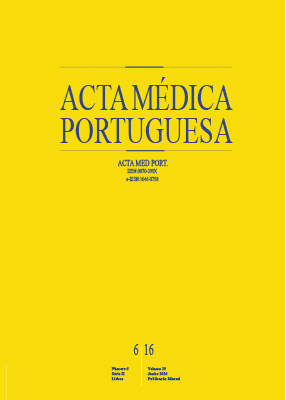Establishing the Role of Unlinked Total Elbow Arthroplasty in Low Demand Patients: A Long-Term Follow-up Study
DOI:
https://doi.org/10.20344/amp.6064Keywords:
Arthroplasty, Replacement, Elbow Joint, Joint Prosthesis, Treatment Outcome.Abstract
Introduction: Experience with total elbow arthroplasty is scarce in most centers. It seems to have a significant rate of associated complications. Most studies are based on non-validated outcome measures and short-term results.
Material and Methods: We selected patients undergoing unlinked total elbow arthroplasty, with a resultant sample of thirteen cases, with a mean postoperative follow-up of 72 months. We applied the Mayo Elbow Score and all patients underwent an X-ray study, prior to surgery and during the follow-up period.
Results: All patients have a systemic inflammatory condition. The mean Mayo score increased from 43 points preoperatively to 70 and 80 points at the intermediate follow-up period (with a mean of 15 months after the operation) and at the time of the latest follow-up evaluation (with a mean of 72 months after the operation). There was an increase in range of motion in all cases. There was one case of mechanical failure and two cases of transient ulnar neuropathy.
Discussion: Elbow dysfunction causes great loss in patient´s quality of life, incapacitating them for the simplest activities. Small improvements in range of motion and pain relief result in significant changes in the patient’s functional ability. There is a demand to clarify the performance of total elbow arthroplasty in selected patient groups in order to throw more light on the relative roles of the available implants.
Conclusions: The results obtained in this study seem to confirm the long-term benefit of the unlinked arthroplasty in severe joint dysfunction in patients with low physical demand, particularly in rheumatoid arthritis, a common and limiting condition in our population.
Downloads
Downloads
Published
How to Cite
Issue
Section
License
All the articles published in the AMP are open access and comply with the requirements of funding agencies or academic institutions. The AMP is governed by the terms of the Creative Commons ‘Attribution – Non-Commercial Use - (CC-BY-NC)’ license, regarding the use by third parties.
It is the author’s responsibility to obtain approval for the reproduction of figures, tables, etc. from other publications.
Upon acceptance of an article for publication, the authors will be asked to complete the ICMJE “Copyright Liability and Copyright Sharing Statement “(http://www.actamedicaportuguesa.com/info/AMP-NormasPublicacao.pdf) and the “Declaration of Potential Conflicts of Interest” (http:// www.icmje.org/conflicts-of-interest). An e-mail will be sent to the corresponding author to acknowledge receipt of the manuscript.
After publication, the authors are authorised to make their articles available in repositories of their institutions of origin, as long as they always mention where they were published and according to the Creative Commons license.









